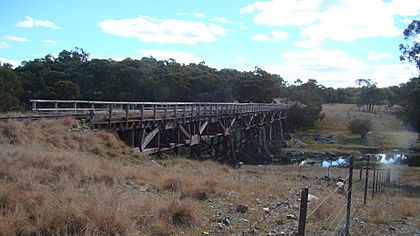Yarraford Rail Bridge over Beardy Waters facts for kids
Quick facts for kids Yarraford rail bridge |
|
|---|---|

The Yarraford rail bridge, in 2011
|
|
| Coordinates | 29°38′16″S 151°46′51″E / 29.6378°S 151.7809°E |
| Carries | Main Northern line |
| Crosses | Beardy Waters |
| Locale | Glen Innes, Glen Innes Severn, New South Wales, Australia |
| Other name(s) | Beardy River Railway Viaduct |
| Owner | RailCorp |
| Characteristics | |
| Design | Queen post truss |
| Material | Timber |
| Longest span | 12 metres (40 ft) |
| Number of spans | 9 |
| History | |
| Engineering design by | John Whitton |
| Construction begin | 1884 |
| Construction end | 1886 |
Official name:
|
|
| Type: | State heritage (built) |
| Designated: | 2 April 1999 |
| Reference #: | 01068 |
| Type: | Railway Bridge/ Viaduct |
| Category: | Transport - Rail |
The Yarraford Rail Bridge is an old railway bridge in New South Wales, Australia. It's near Glen Innes and crosses a waterway called Beardy Waters. This bridge was once part of the Main Northern railway line.
The bridge was designed by John Whitton, a famous railway engineer, and finished in 1886. It is also known as the Beardy River Railway Viaduct. Today, the bridge is owned by RailCorp, a government agency in New South Wales. It was added to the New South Wales State Heritage Register on April 2, 1999, which means it's an important historical structure.
Contents
Building the Main North Railway Line
The Main North Railway Line was a big project to connect different parts of New South Wales.
Early Challenges in Railway Building
Between 1870 and 1884, John Whitton was in charge of extending the railway from Muswellbrook to Glen Innes. This part of the line went through the Great Dividing Range. Building here was tough because of steep hills and sharp turns. It also needed a lot of earthworks and strong iron bridges. This made the construction very expensive.
Smart Choices for Bridge Design
When the railway was planned to go from Glen Innes to Tenterfield, they needed to save money. This meant using timber for bridges instead of more expensive materials. Three large bridges were needed: over Beardy Waters, the Severn River, and the Bluff River.
Whitton, who was a skilled engineer from England, decided to use a design from another famous engineer, Isambard Kingdom Brunel. Brunel had built similar timber bridges in Cornwall, England, in the 1850s. The design was called the St Germans Viaduct.
How the Yarraford Bridge Was Built
The original St Germans Viaduct used a mix of timber and iron rods. Whitton's team changed the design to use only timber for the main parts. These new timber bridges, including the Yarraford Rail Bridge, were built between 1884 and 1886.
Later, another similar timber bridge was built over Tenterfield Creek. This was for the final section of the railway to Wallangarra, which opened in 1888.
Other Bridges of This Type
Only two other bridges like these were built during this time. They are the Ingalara Creek railway bridge and the Bredbo River railway bridge. Both of these are on the Bombala railway line.
What the Yarraford Bridge Looks Like
The Yarraford Rail Bridge is a long structure made of timber.
Bridge Structure and Materials
The bridge has nine sections, called spans. Each span is about 12 metres (40 ft) long. These sections are supported by strong timber frames called trestles.
The main parts of the bridge are called trusses. These are shaped like a "Queen post" design. This design was copied from Brunel's old timber bridges in Cornwall.
Current Condition of the Bridge
As of 2006, the bridge was in fair condition. It had become a bit worn because trains no longer use it, and it hasn't been maintained as much. However, like the other similar bridges on this railway line, it still has its original parts.
Why the Bridge Is Important
The Yarraford Rail Bridge is listed on the New South Wales State Heritage Register. This means it's important for several reasons.
Historical Significance
The timber Queen post truss bridges were a smart and affordable choice for the railway. They were built when money for railway construction was becoming tighter in the 1880s.
Design and Beauty
Even though they are a bit hard to reach, these timber bridges over the Beardy, Severn, and Bluff Rivers are impressive. They stand out in the countryside. The bridge near Tenterfield is easy to see from the New England Highway.
Community Connection
The Main North Railway helped the New England Region grow a lot between 1882 and 1888. These four timber bridges were a key part of that important railway system.
Learning from the Bridge
These timber bridges were a great solution instead of the more expensive iron bridges that John Whitton usually preferred. They were well-built and strong, made from tough ironbark hardwood. They show how engineers found clever ways to build railways.
Rarity of the Bridge Design
The Yarraford Rail Bridge and the other three like it on this line, plus two on the Cooma Line, are the only bridges of their kind ever built. This makes them very unique railway bridges.

